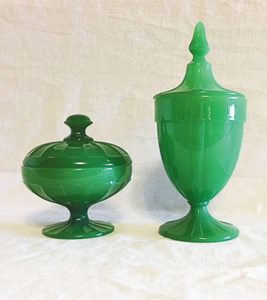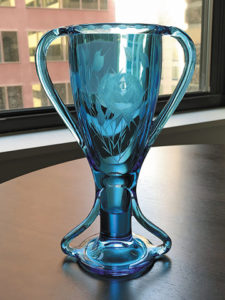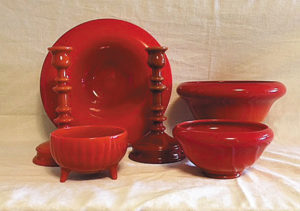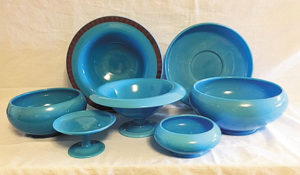 By Tom Cotter
By Tom CotterCambridge, Diamond, Fenton, Tiffin photos by Barb Garrison Fostoria photo by Alex Kizewski, Cambridge Rubina photos by Tom Cotter
The grand and glorious 1920s. The United States dominated the world in nearly every phase of life. Glass was a big part of that dominance; glass for automobiles, airplanes, trains, homes, radios, and on and on. 1920 marked the first census when urban population exceeded rural population. Product distribution included ever increasing shipments of finished products to wholesalers and retailers, mostly by a continuously expanding railway system with the States. Combined with the infusion of automobiles and mass human transportation along with great expansion of eight hour workdays, people found they could buy and furnish their homes. With more disposable income and time, more people were able to acquire attractive decorations and housewares. This often meant glass. Although alcoholic beverages were outlawed throughout the 1920s by Prohibition, demand for wine and liquor glasses and containers surged. Maybe for coffee (hot toddies), juice (wine), sodas (beer), and tea (whiskey)? Home refrigerators replaced true ice boxes in many homes. People began to use more glass containers in their refrigerators as well as for dry goods storage. While some of these items might have had plain functional appearances, the glass companies competed avidly to capture their “fair share” of the growing marketplace. Some may have followed Say’s law: “Supply creates its own demand”. Often this included experimenting with and marketing a great variety of glass colors, all designed to lure the unwary consumer.
 The heart of the glass industry in the 1920s was the Ohio and Monongahela River Valleys, with extensive resources in silica sand, coal and natural gas power, clay for pots, iron and steel, and an abundance of labor, often very skilled. Within about 125 miles from and including Wheeling, WV, were the companies of Beaumont, Cambridge, Central, Cooperative Flint, Diamond, Duncan-Miller, Dunbar, Economy (later Morgantown), Fenton, Fostoria, H. C. Fry, Hazel-Atlas, A. H. Heisey, Hocking, Imperial, Jeanette, Lancaster, McKee, New Cumberland, New Martinsville, H. Northwood, Paden City, L.E. Smith, Westmoreland, and the U.S. Glass headquarters in Pittsburgh, among others. Knowledge, employees, marketers, and supplies moved throughout this region to help the boom in the glass industry directed at citizens more than corporations.
The heart of the glass industry in the 1920s was the Ohio and Monongahela River Valleys, with extensive resources in silica sand, coal and natural gas power, clay for pots, iron and steel, and an abundance of labor, often very skilled. Within about 125 miles from and including Wheeling, WV, were the companies of Beaumont, Cambridge, Central, Cooperative Flint, Diamond, Duncan-Miller, Dunbar, Economy (later Morgantown), Fenton, Fostoria, H. C. Fry, Hazel-Atlas, A. H. Heisey, Hocking, Imperial, Jeanette, Lancaster, McKee, New Cumberland, New Martinsville, H. Northwood, Paden City, L.E. Smith, Westmoreland, and the U.S. Glass headquarters in Pittsburgh, among others. Knowledge, employees, marketers, and supplies moved throughout this region to help the boom in the glass industry directed at citizens more than corporations. For the generally less decorative container market, many companies updated to continuous tank glass production powered by glass furnaces. Women were “encouraged” to become savvier in their “daily chores” through Home Economics programs in schools and magazines such as Good Housekeeping directed at “homemakers”. Companies like Corning (Pyrex) H.C. Fry, and McKee (GlasBake) offered pieces that combined cooking, serving, and storage. Less expensive tumblers, luncheon, dessert, and grill plates in addition to sugars, creamers and service pieces were readily available for daily use from companies such as Belmont, Federal, Hazel-Atlas, Hocking, Indiana, Jeanette, and U.S. Glass. Part of the appeal for a lot of kitchenware came from using glass formulas that made pastel pink, green, amber, and yellow pieces in a variety of pressed patterns by a number of companies. While “Depression Glass” became the common term for much of this continuous process, patterns like Indiana’s Avocado and Pyramid, Jeanette’s Iris, and Fenton’s Lincoln Inn originated before the Great Depression. The Tea Room pattern by Indiana was designed specifically for the ice cream and soda fountain businesses, another fast-growing business in the 1920s that used a lot of glassware. Years of experimentation and development by English-born glass chemists like Frederick Carder of Steuben and Arthur J. Nash at Tiffany generated never-before seen colors in a very exclusive, wealth-based market. To compete, within their growing market niche, less expensive glass makers known as “Elegant” companies (those with hand processing of some sort) created so many named colors that it is impossible to list all in one short article. This is the “More Than a Rainbow” aspect in our title. Remember the rainbow by ‘Roy G. Biv’, or Red, Orange, Yellow, Green, Blue, Indigo, and Violet? In addition to similar pastels in the tank glass companies, “Elegant” makers made nearly all shades of those 7 Rainbow Colors, and many between and outside the rainbow. Although “Carnival”, especially on Pattern glass, was becoming passé before the 20s, companies found a replacement in “Stretch” glass, with sprayed metallic salts applied to hot glass, reheated and re-shaped by hand to produce showy finishes. Often called Luster or Lustre, “Stretch” finishes were generally applied to transparent or opaque decorative and serving items. This technique created an array of colors, sometimes differing significantly from the base color of the piece.
 From the visible spectrum, reds came in opaque and transparent versions; Fenton alone made Ruby, Mandarin Red Opaque, Ruby Carnival, Spanish Red, and Red Stretch. Other companies applied their own names, such as Sunset and some Amberinas. Somewhat related to red was a vast array of pink glassware, with names like Velva Rose, Peach-blo, Rose, Peach, Peach Melba, and sometimes just pink. Orange showed up in Coral Red, Tangerine, Chinese Coral, Sunset, and Amberina. Amber was common, but varied; most companies simply called it amber, but finishes created names of Russet, Gold, Cameo Opalescent, and others. Yellow transparent colors came in Topaz, Grecian Gold, Gold Krystol, etc., but opaque colors Chinese Yellow, Mandarin Yellow, Primrose, and on appeared. In the green segments were Emeralds or green, while opaque might be called Jade. Blues ranged from a barely discernable Willow Blue through Aquamarine, Azure, Celeste, Electric, and Bluebell to deep Royal Blue, with a variety of transparent and opaque versions. Purples and violets might be pale Orchid through deep Amethyst, with opaque represented by Cambridge Helio, but not much else. At the opposite ends of the rainbow were white (Milk, Carrara, Ivory, Fer-Lux, etc.) and black (Ebony). One of the more intriguing lines of the 20s was Cambridge Rubina, a reheated ruby-based formula that varied from deep red to green to exquisite blue within a single piece. This is one of my favorites.
From the visible spectrum, reds came in opaque and transparent versions; Fenton alone made Ruby, Mandarin Red Opaque, Ruby Carnival, Spanish Red, and Red Stretch. Other companies applied their own names, such as Sunset and some Amberinas. Somewhat related to red was a vast array of pink glassware, with names like Velva Rose, Peach-blo, Rose, Peach, Peach Melba, and sometimes just pink. Orange showed up in Coral Red, Tangerine, Chinese Coral, Sunset, and Amberina. Amber was common, but varied; most companies simply called it amber, but finishes created names of Russet, Gold, Cameo Opalescent, and others. Yellow transparent colors came in Topaz, Grecian Gold, Gold Krystol, etc., but opaque colors Chinese Yellow, Mandarin Yellow, Primrose, and on appeared. In the green segments were Emeralds or green, while opaque might be called Jade. Blues ranged from a barely discernable Willow Blue through Aquamarine, Azure, Celeste, Electric, and Bluebell to deep Royal Blue, with a variety of transparent and opaque versions. Purples and violets might be pale Orchid through deep Amethyst, with opaque represented by Cambridge Helio, but not much else. At the opposite ends of the rainbow were white (Milk, Carrara, Ivory, Fer-Lux, etc.) and black (Ebony). One of the more intriguing lines of the 20s was Cambridge Rubina, a reheated ruby-based formula that varied from deep red to green to exquisite blue within a single piece. This is one of my favorites. A good source of information on the 1920s glass companies is a two-volume set titled Great American Glass of the Roaring 20s & Depression Era by James Measell and Berry Wiggins. Although out of print, it is available at the Rocky Mountain Depression Glass Club library (members only), as well as several online sources. I am continually grateful that the DeStefanos continue to promote collecting within our region via the Mountain States Collector. They have been a joy to work with over the last few years and are a beacon for all types of collecting hobbies. With Jodi and Mark Uthe sponsoring the Front Range Glass Show, this year September 29 and 30 at the Ranch Events Complex near Loveland, we are fortunate to have such a show in our region devoted exclusively to antique and vintage glass, china, and pottery. Jodi and Mark have gathered a great lineup of dealers from across the country again this year. Information for the show is on the RMDGS website about the club and show (www.RMDGS.com & SHOWS). This also links to http://www.frontrangeglassshow.com/, which has more specifics about the show. Please continue to support malls, shops, and shows throughout Colorado and adjoining states. Colorize your days with beautiful glass, china and pottery. There’s more than a rainbow out there for the finding.
A good source of information on the 1920s glass companies is a two-volume set titled Great American Glass of the Roaring 20s & Depression Era by James Measell and Berry Wiggins. Although out of print, it is available at the Rocky Mountain Depression Glass Club library (members only), as well as several online sources. I am continually grateful that the DeStefanos continue to promote collecting within our region via the Mountain States Collector. They have been a joy to work with over the last few years and are a beacon for all types of collecting hobbies. With Jodi and Mark Uthe sponsoring the Front Range Glass Show, this year September 29 and 30 at the Ranch Events Complex near Loveland, we are fortunate to have such a show in our region devoted exclusively to antique and vintage glass, china, and pottery. Jodi and Mark have gathered a great lineup of dealers from across the country again this year. Information for the show is on the RMDGS website about the club and show (www.RMDGS.com & SHOWS). This also links to http://www.frontrangeglassshow.com/, which has more specifics about the show. Please continue to support malls, shops, and shows throughout Colorado and adjoining states. Colorize your days with beautiful glass, china and pottery. There’s more than a rainbow out there for the finding.














Follow Us